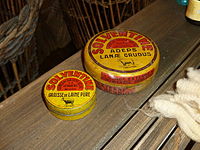
Photo from wikipedia
The integuments of ten treefrog species of two genera from Scinaxnae – O. angrensis (Lutz, 1973), O. flavoguttata (Lutz & Lutz, 1939), O. humilis (Lutz & Lutz, 1954), O. perpusilla… Click to show full abstract
The integuments of ten treefrog species of two genera from Scinaxnae – O. angrensis (Lutz, 1973), O. flavoguttata (Lutz & Lutz, 1939), O. humilis (Lutz & Lutz, 1954), O. perpusilla (Lutz & Lutz, 1939), O. v-signata (Lutz, 1968), Scinax hayii (Barbour, 1909), S. similis (Cochran, 1952), O. trapicheroi (Lutz & Lutz, 1954) and S. x-signatus (Spix, 1824) – were investigated using conventional and histochemical techniques of light microscopy, and polarized light microscopy. All integuments showed the basic structure of the anuran integument. Moreover, the secretory portions of exocrine glands, such as serous merocrine and apocrine glands, were found to be restricted to the spongious dermis. Lipid content occurred together with the heterogeneous secretory material of the glands with an apocrine secretion mechanism. In addition, clusters of these apocrine glands were present in the ventrolateral integument of some species. Melanophores were also visualized in all examined hylids. However, the occurrence of iridophores, detected through polarized light microscopy, varied according to the species. The Eberth-Katschenko layer occurred in the dorsal integument from both genera, but it was only present in the ventral integument of O. albicans, O. angrensis, O. flavoguttata, O. perpusilla and O. v-signata. Although the integument of all treefrogs showed the same basic structure, some characteristics were genus-specific; however, these features alone may not be used to distinguish both genera.
Journal Title: Zoologia
Year Published: 2017
Link to full text (if available)
Share on Social Media: Sign Up to like & get
recommendations!